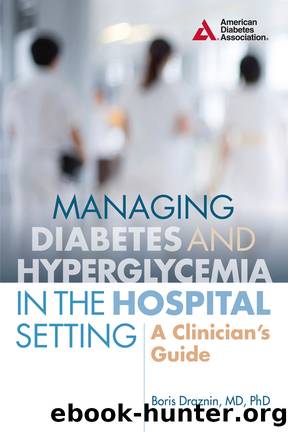Managing Diabetes and Hyperglycemia in the Hospital Setting by Boris Draznin

Author:Boris Draznin
Language: eng
Format: epub
Tags: ebook
Publisher: American Diabetes Association
Published: 2016-01-15T00:00:00+00:00
A variety of circumstances that markedly increase insulin resistance among hospitalized patients are discussed in detail elsewhere in this book. This chapter discusses the pathogenesis and therapeutic approach to patients with severe insulin resistance induced by therapeutic hypothermia and by severe burns.
Therapeutic Hypothermia
Therapeutic hypothermia (also called targeted temperature management) is used widely in patients with in- or out-of-hospital cardiac arrest. Therapeutic hypothermia significantly improves neurological deficits and survival in these patients.7 Duration of cooling varies considerably, ranging from 2â3 days to up to 10 days. Body temperature can be lowered to 34â35.9°C, 32â33.9°C, or 30â31.9°C, for mild, moderate, or moderate-deep hypothermia, respectively.8 Deep hypothermia (<30°C) is rarely used as it is associated with a much greater risk for severe side effects. In fact, a recent international, multicenter, randomized trial suggested that a temperature <36°C (targeted at 33°C) did not confer any additional benefit.9
When the core temperature drops to 32°C, the metabolic rate decreases to 50â65% of normal, and oxygen consumption and CO2 production decrease by the same percentage. At the same time, the levels of free fatty acids, ketones, and lactate increase.10
Another important consequence of hypothermia is decreased insulin secretion and moderate to severe insulin resistance leading to hyperglycemia, particularly in patients with diabetes.11,12 The mechanism of severe insulin resistance in hypothermia is not well understood, but diminished insulin binding to its receptor as well as diminished signal transduction and human glucose transporter (GLUT-4) function (recruitment of glucose transporters to the plasma membrane and their subsequent internalization) certainly play a significant role.12 All steps involved in mediating insulin action on glucose transport and intracellular metabolism are significantly diminished by lower temperature. Undoubtedly, vasoconstriction and possible changes in adrenergic tone might contribute as well. Furthermore, hypothermia may induce accumulation of lactate and mild acidosis, which diminishes insulin sensitivity.
At the same time, impaired insulin release also could contribute to hyperglycemia.11 The mechanism of this impairment is hypothesized to include diminished intracellular metabolism of glucose and slower rates of fusion and fission of insulin-containing secretory vesicles in the pancreatic β-cells under hypothermic conditions.
As a result, in some patients, particularly in those with diabetes, hyperglycemia can be extreme, approaching or exceeding 1,000 mg/dL (55.6 mM/L). The insulin requirement is greatly increased, and frequently intravenous (IV) insulin infusion at the rate of 20 to 30 units/h may be insufficient to control hyperglycemia.
Clinical implications of the temperature dependence of insulin action become particularly important in the rewarming phase. With the core temperature rising, both insulin release and insulin action improve dramatically and, with large quantities of exogenous insulin on board, hypoglycemia may ensue precipitously. The insulin infusion rate must be decreased aggressively in the rewarming phase to avoid hypoglycemia. In practical terms, the danger of hypoglycemia during the rewarming phase is the most important point to remember during the management of glycemia in patients with therapeutic hypothermia. A concomitant infusion of D10% may be needed in addition to a reduction in the insulin infusion rate to stabilize glycemia and prevent hypoglycemia in the rewarming phase.
Overall, early
Download
This site does not store any files on its server. We only index and link to content provided by other sites. Please contact the content providers to delete copyright contents if any and email us, we'll remove relevant links or contents immediately.
Human Diseases (MindTap Course List) (by Team-IRA) by Marianne Neighbors Ruth Tannehill-Jones(872)
Cancer Cell Culture by Unknown(430)
The Neglected Dimension of Global Security: A Framework to Counter Infectious Disease Crises by National Academy of Medicine Secretariat(430)
Statistical Methods in Health Disparity Research by J. Sunil Rao(407)
Imaging in Urology by Mitchell Tublin MD Joel B Nelson MD(402)
Short Course in Medical Terminology by Nath Judi L.;(340)
Health Behavior: Theory, Research, and Practice by Karen Glanz & Barbara K. Rimer & K. Viswanath(330)
Wilkins' Clinical Practice of the Dental Hygienist by Boyd Linda D.;Mallonee Lisa F.; & Lisa F. Mallonee(312)
Achieving Procreation : Childlessness and IVF in Turkey by Merve Demircioğlu Göknar(311)
Clinical Research in Occupational Therapy, Sixth Edition by Martin Rice;(304)
Murray's Basic Medical Microbiology E-Book by Murray Patrick R.;(292)
Anatomical Kinesiology by Gross Michael;(290)
Neuroscience Fundamentals for Rehabilitation by Lundy-Ekman Laurie(283)
Psychedelics As Psychiatric Medications by Nutt David;Castle David;(282)
The Human Central Nervous System by Unknown(270)
A Pocket Guide for Medical Students: From Enrollment to Job Interviews by Sarah Cuschieri(266)
Rang & Dale's Pharmacology 9th Edition plus Flashcards 2nd Edition by Unknown(256)
The Handbook of Medicinal Chemistry by Simon E Ward;Andrew Davis;(252)
Public Health and Society: Current Issues by Burke Lillian D.;Weill Barbara;(252)
